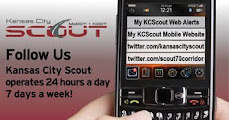
I grew up in the Kansas City area and in 1990 at the driving age of 28, I moved to San Diego, CA living there for more than 10 years. Even for the “experienced driver” I considered myself to be, at first driving in San Diego was challenging with its five-lane interstates, busy on- and off-ramps and constant traffic flow.
One of the things that helped me master the busy freeways were ramp meters.
Ramp meters are special traffic signals that regulate the rate at which vehicles enter the freeway from the on-ramps. I had no problems using the metered ramps for the first time. In fact, it was quite simple. Meters in Kansas City, like those in San Diego will include flashing yellow lights near the ramp entrance to alert drivers that the meter is on and they should be prepared to stop. Signs and pavement markings will tell drivers where to stop and how to proceed. A red light means stop and a green light means go. A typical meter cycle is about two seconds of green and two to ten seconds of red, making the wait on the ramp usually about one minute. The minute was well worth the wait once I reached the bottom of the ramp and didn’t have to fight with ten other cars to make my way onto an already congested freeway.
When I moved back to Kansas City and learned of Scout’s Ramp Metering Project for the South I-435 corridor, I was very excited about it. Ramp meters improve safety by reducing rear-end and sideswipe accidents; they also lessen congestion that happens when groups of cars enter the freeway and compete for openings in the flow of traffic. Any time spent waiting on the on-ramps is made up in travel time savings once on the freeway. In addition, ramp meters are Green. They help lower vehicle emissions and fuel consumption by decreasing the time that cars spend waiting in traffic.
One of the things that helped me master the busy freeways were ramp meters.
Ramp meters are special traffic signals that regulate the rate at which vehicles enter the freeway from the on-ramps. I had no problems using the metered ramps for the first time. In fact, it was quite simple. Meters in Kansas City, like those in San Diego will include flashing yellow lights near the ramp entrance to alert drivers that the meter is on and they should be prepared to stop. Signs and pavement markings will tell drivers where to stop and how to proceed. A red light means stop and a green light means go. A typical meter cycle is about two seconds of green and two to ten seconds of red, making the wait on the ramp usually about one minute. The minute was well worth the wait once I reached the bottom of the ramp and didn’t have to fight with ten other cars to make my way onto an already congested freeway.
When I moved back to Kansas City and learned of Scout’s Ramp Metering Project for the South I-435 corridor, I was very excited about it. Ramp meters improve safety by reducing rear-end and sideswipe accidents; they also lessen congestion that happens when groups of cars enter the freeway and compete for openings in the flow of traffic. Any time spent waiting on the on-ramps is made up in travel time savings once on the freeway. In addition, ramp meters are Green. They help lower vehicle emissions and fuel consumption by decreasing the time that cars spend waiting in traffic.
I look forward to November 2009 when the meters turn on along I-435 from Metcalf Avenue going east to the Three Trails Memorial Crossing (formerly the Grandview Triangle). Then I will be able to look in my rearview mirror and wave goodbye to all those instances where I was “forced” to suddenly switch lanes or hit my brakes to make room for seven or eight vehicles merging onto the freeway at once.
For more information on Kansas City Scout’s Ramp Metering Project visit our webpage at http://www.kcscout.com/RampMetering, also check out the on-line meeting and watch for dates and locations of public meetings coming soon.





